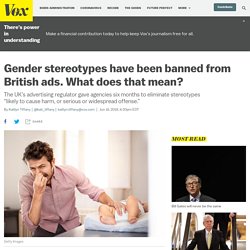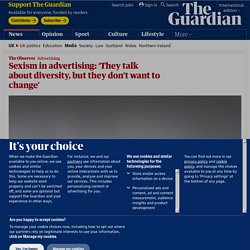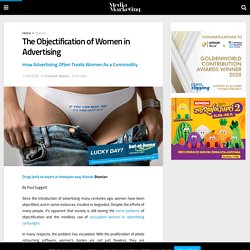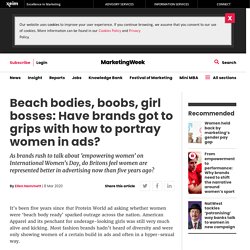

Birmingham City University - Sign In. Body positivity, diversity and strong women: the new rules of beauty advertising. Beauty advertising has been successfully selling female consumers "hope in a jar for generations" but it is a strategy that is long past its sell-by date.

Take the visceral reaction to beauty and fashion icon Kim Kardashian’s ad for a dieting lolly earlier this month. Kardashian removed the Instagram after a swift and furious social media backlash. Beauty advertising has traditionally been one of the worst offenders for embellishing reality and selling women idealised and restrictive forms of perfection, underpinned by extreme airbrushing and dubious claims. However, recently, the big trend in beauty has been for hyper realness, with diverse models, bold statements of ’no-airbushing’ and simplified and playful product packaging. A shift reflected by new beauty players such as Crayola coming into the market promising to put the fun back into beauty.
Q: Why are consumers rejecting 'fake' beauty ads? A: There are two primary drivers. The second is a more active rejection. A: In short, yes. How Should Women Be Portrayed in Advertisements? ABSTRACT - The roles which women portray in advertisements have been the subject of much public criticism and some empirical research.

This paper reviews that research, describes problem areas which need research and presents hypotheses whose exploration should provide useful insights aimed at improving both advertising and over-all marketing strategy. Citation: Mary Lou Roberts and Perri B. Koggan (1979) ,"How Should Women Be Portrayed in Advertisements? -- a Call For Research", in NA - Advances in Consumer Research Volume 06, eds. . , Pages 66-72 , Boston University , Grey Advertising, Inc. The roles which women portray in advertisements have been the subject of much public criticism and some empirical research. Gender stereotypes in advertising have been banned in the UK.
Playing off gender stereotypes to sell stuff is now explicitly against the law for advertisers in the UK.

Britain’s Advertising Standards Authority announced the ban in December, with a six-month buffer period before it went into effect. And that announcement came shortly after the ASA published a 64-page report on how gender stereotypes in ads “can lead to unequal gender outcomes in public and private aspects of people’s lives,” citing public opinion and various experts. The report was prompted by a series of widely reviled ads in the UK, including those for a Protein World weight loss drink marketed with the tagline “Are you beach body ready?” Sexism in advertising: ‘They talk about diversity, but they don’t want to change’ In 2017, Victoria Brooks, the vice-president of Bloom, a network for women in advertising and communications, had an idea.

Aware that there were some subjects its members found difficult to discuss even among supportive peers, she decided to set up what would come to be known as the Booth of Truth at the organisation’s inaugural day-long conference in Clerkenwell, London. Inside this enclosed space, women would be able to write down their experiences of such things as discrimination and sexual harassment, safe in the knowledge that they would be anonymous. These anecdotes would then be used at the end of the day as fodder for a panel discussion and advice session that she and the president of Bloom, Stephanie Matthews, would call Confessions Live.
The first booth (there have since been others) was inflatable, and resembled an igloo. It contained a sofa, a selection of coloured pens, and a box into which the confession cards could be posted. A lot has changed. 57153 book item 57153. The Objectification of Women in Advertising. Drugi jezik na kojem je dostupan ovaj članak: Bosnian By Paul Suggett Since the introduction of advertising many centuries ago, women have been objectified, and in some instances, insulted or degraded.

Despite the efforts of many people, it’s apparent that society is still seeing the same patterns of objectification and the mindless use of sexualized women in advertising campaigns. In many respects, the problem has escalated. With the proliferation of photo retouching software, women’s bodies are not just flawless, they are anatomically impossible. Advertising False Ideals Advertising, marketing, and the fashion industry have created a new type of woman that does not exist in the real world. She has no wrinkles, blemishes, or scars.She has long, smooth, and shapely legs.Her waist is quite small.Her ample breasts and buttocks defy gravity.Her radiant hair looks like CGI.Her eyes are dazzling and bright.Her teeth are shining white and perfectly straight. Exploiting Learned Desires. Half of women think female representation in advertising has improved. Have brands got to grips with how to portray women in ads? It’s been five years since that Protein World ad asking whether women were ‘beach body ready’ sparked outrage across the nation.

American Apparel and its penchant for underage-looking girls was still very much alive and kicking. Most fashion brands hadn’t heard of diversity and were only showing women of a certain build in ads and often in a hyper-sexual way. The likes of Missguided and Prettylittlething continue to have ads banned for showing female models wearing very few clothes, while ads like People Per Hour’s ‘You do the girl boss thing, we’ll do the SEO thing’ show that the days of peddling outdated gender stereotypes are far from over.
It was only in January that KFC apologised for an ad in Australia showing two young boys staring at a woman as she adjusted her breasts. But there are signs that things are changing, albeit slowly. Again, women have a less positive view on how they are portrayed. Inclusion agenda This is a step in the right direction. Provocative Female Models In Advertising: Triggering Indirect Aggression – Brand Quarterly.